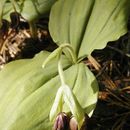en
names in breadcrumbs


Vance, N. 2005. Conservation Assessment for Cypripedium fasciculatum. USDA Forest Service Region 6 and USDI Bureau of Land Management, OR/WA.
Reconfigured from
Seevers, J. and F. Lang. 1998. Management Recommendations for Cypripedium fasciculatum.USDA Forest Service Region 6 and USDI Bureau of Land Management, OR/WA.
Cypripedium fasciculatum, the clustered lady's slipper,[3] is a member of the orchid genus Cypripedium. Members of this genus are commonly referred to as lady's slippers. C. fasciculatum, along with C. montanum and C. californicum, are the only members of the genus Cypripedium that are endemic to western North America.
C. fasciculatum has two plicate leaves that are usually near the ground, but can by elevated up to 15 cm (5.9 in) in some individuals. Up to four flowers hang from a drooping stem, sometimes resting on the leaves or even on the ground. The petals and sepals are green to purplish-brown while the pouch is yellowish-green with purple streaking near the opening.
C. fasciculatum is found in the western United States in Washington, Oregon, California, Colorado, Montana, Idaho, Utah, and Wyoming.[4][5] It is usually found in cool, open coniferous forests, mostly in the mountains.
Cypripedium fasciculatum, the clustered lady's slipper, is a member of the orchid genus Cypripedium. Members of this genus are commonly referred to as lady's slippers. C. fasciculatum, along with C. montanum and C. californicum, are the only members of the genus Cypripedium that are endemic to western North America.